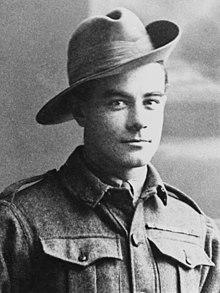Arthur Sullivan | |
|---|---|
 Sullivan c. 1919 | |
| Born | 27 November 1896 Prospect, South Australia |
| Died | 9 April 1937 (aged 40) Westminster, United Kingdom |
| Allegiance |
|
| Service |
|
| Years of service | 1918–1919 |
| Rank | Corporal |
| Unit |
|
| Battles / wars | |
| Awards | Victoria Cross |
| Spouse(s) |
Dorothy Frances Veale
(m. 1928) |
| Children | 3 |
Arthur Percy Sullivan VC (27 November 1896 – 9 April 1937) was an Australian recipient of the Victoria Cross (VC), the highest award for gallantry in the face of the enemy that can be awarded to a member of the British Armed Forces. Born in South Australia, Sullivan worked for the National Bank of Australasia prior to enlisting in the Australian Imperial Force (AIF) in April 1918 for service in World War I. He had arrived in the United Kingdom, but had not completed training when the Armistice came into effect on 11 November. Sullivan was promoted to corporal in March 1919, but wanting to see active service he sought and received his discharge from the AIF on 28 May. On the same day, he enlisted in the British Army for service with the North Russia Relief Force, part of the Allied intervention in the Russian Civil War.
Sullivan was deployed to northern Russia with the relief force. Following a successful attack, he was a member of the rearguard of a column withdrawing across the Sheika River. As his platoon crossed the river on a crude one-plank bridge in the early hours of 11 August 1919, it came under intense fire from Bolshevik troops, and four members fell into the river. Sullivan immediately jumped in and rescued them all, one by one, and was awarded the VC for his actions. Demobilised from the British Army after completing his service, Sullivan returned to Australia and resumed his civilian career as a banker. He was in London for the coronation of King George VI as part of the Australian Coronation Contingent in 1937, when he died of head injuries received in a fall. His medal set is displayed in the Hall of Valour at the Australian War Memorial in Canberra.